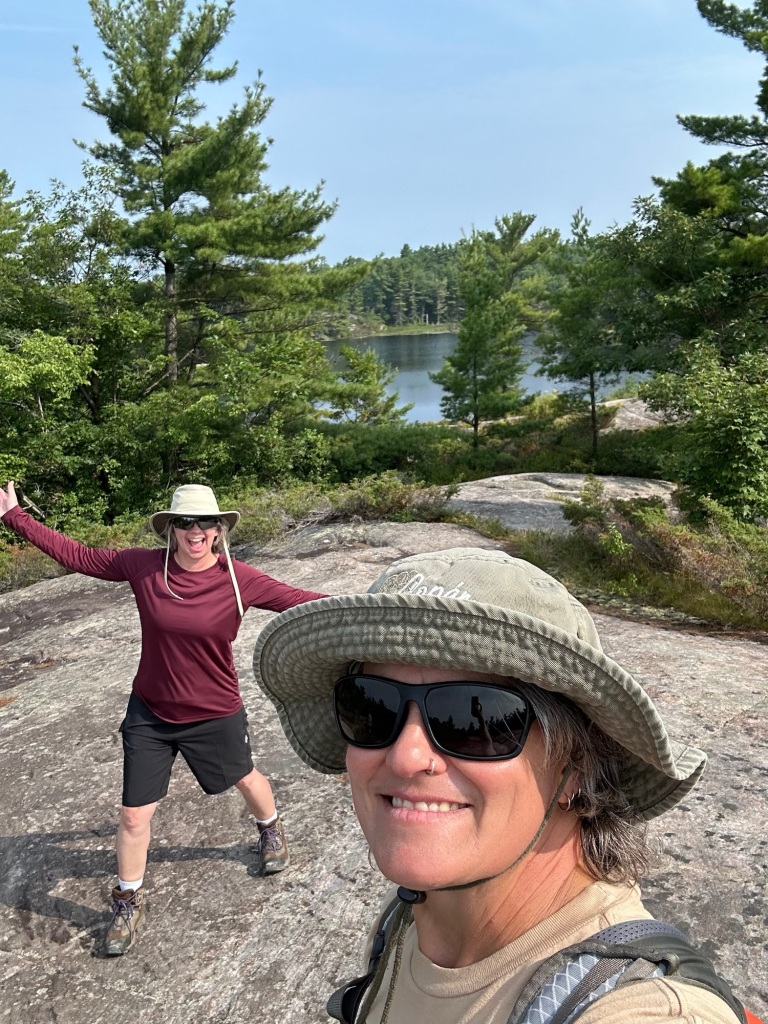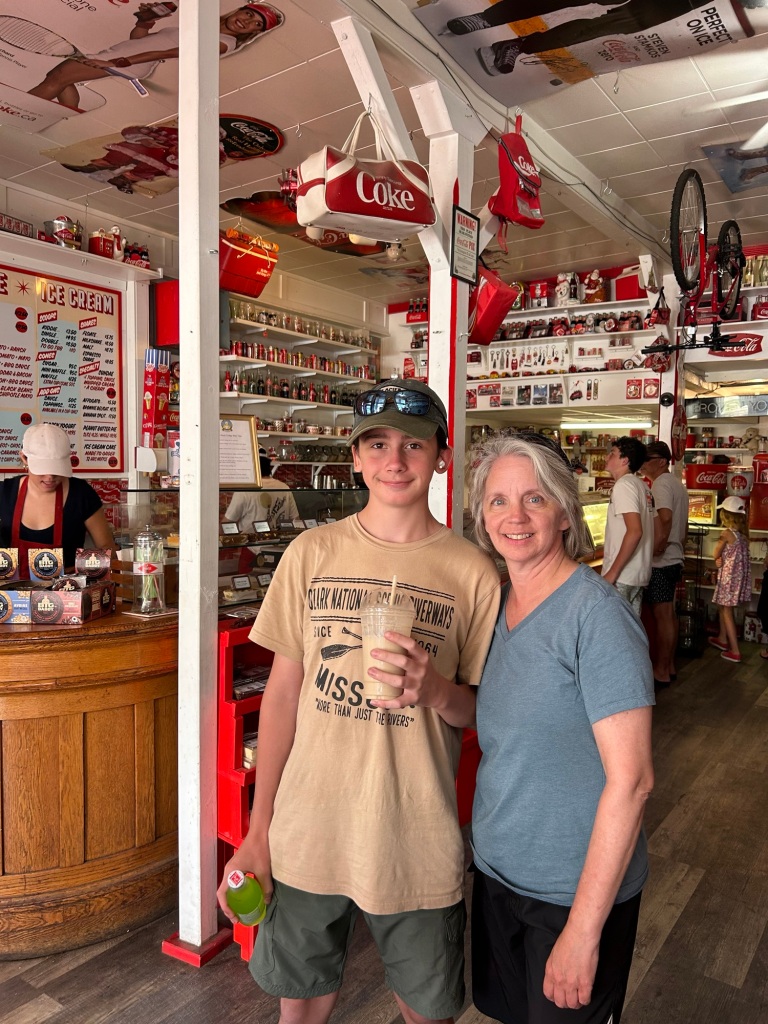Day 4
- Elizabeth Jaeger

- Aug 2, 2024
- 7 min read
I am really bummed about leaving that campsite. It’s not even like we live close enough to return for a long weekend. Oh well, more adventure awaits and that’s what is important. This morning we are heading to Georgian Bay National Park. Last night, I spoke to my brother. He is visiting Mom and had taken her to Jones Beach for the day. When they got in the car to return home, Mom saw she had a missed call from me so Gary, my brother, called from his car. When I told him where we were going next, he reminded me that part of the novel, A Prayer for Owen Meany, took place in Georgian Bay. I was supposed read the book in junior years of high school in my religion class, The Philosophy of Life. I took the class with my best friend Libby. At the time, I was just starting to reevaluate my relationship with reading, but I found Owen Meany so boring, I couldn’t force myself to read it. Libby, however, was a far more conscientious student than I and kept up with her reading every night. Her father drove me to school, so each morning on the way to class, she would fill me in, giving me a detailed synopsis of the chapters I didn’t read. Thanks to her, if I remember correctly, I got an A in the course. Years later, I went back and read every book I skipped in high school, including Owen Meany which I really enjoyed. But I have a terrible memory, and therefore, while I remember one of the characters dodging the Viet Nam draft and escaping to Canada, I didn’t remember the exact location being Georgian Bay. Hard to believe that this reluctant reader would go on to major in English, become an English teacher, start a book club, and be a year out from getting a book published.
We stopped in Midland at a restaurant called Stacked for breakfast. We had wanted to fill up before going to the park since it was highly likely we wouldn’t be able to eat again until tonight. From the outside the place looked like it could be a dive, but inside it was really nice and the food was very good. It was one of the best breakfasts we’ve had while on the road.
Georgian Bay Islands National Park is Canada’s smallest national park. The Georgian Bay Islands are the world’s largest freshwater archipelago. Depending on the depth of Lake Huron in any given year, there are between 30,000 and 70,000 Islands. If the water level is too high, the lake swallows some of the islands. If the water level dips too low, some islands are transformed into isthmuses. Of all the islands in Georgian Bay, only about a dozen are part of the national park. Beausoleil is the biggest. If you look at an ariel view of it, the island resembles a dragon. The first cottages were built in Georgian Bay in 1905, but the Anishinaabeg lived in the area long before the Europeans arrived. In fact many artifacts testifying to their presence have been found in the park.
The only way to explore Beausoleil, and by extension the national park, without your own private boat, is to take the Day Tripper which I booked through the national park. The boat left from Honey Harbor on the mainland at 9:30 and dropped us off at Chimney Bay about fifteen minutes later. Unfortunately, we didn’t have all day on the island because we needed to be back by the dock at 1:15 to get picked up. That severely limited what we were able to see and do on the island. The main priority was swimming. Vacation is not vacation unless you get in the water. But I also wanted to take a hike. Luckily, the beach was over at Honeymoon Bay and the only way to get there was to hike. The Fairy Trail is a 2.75 kilometer loop and halfway around it, another short trail breaks off of it and leads to the beach.

The swimming area is roped off, but neither G3 not I wanted to be contained in the shallow area. We wanted to actually swim and so we swam under the ropes and escaped into the deeper water. We cut across the bay and climbed up rocks slippery with slimy algae or another green substance. G3 wanted to head across a channel to a rock where people were jumping into Huron, but with so much boat traffic, I didn’t think it was safe. G3 sulked and went back into the water. I followed but proved to be far less graceful. Gently making my way over the slimy rocks, I slipped and face planted in the water. It was a controlled fall, so I landed in a way that my body hit only water not rock. As a result, I did not get hurt, but G3 still got a good laugh.
Once in the water, we cut back across the bay to another section where, not surprisingly, G3 found a rock poised in a place where we could jump and not get hurt. And I say we because I really am just a child trapped in a much older person’s body. It was fun. We both jumped several times and would have probably spent the rest of the afternoon doing nothing else except for the fact that if we missed the boat it would have been an extremely long swim back to our car.
The hike out to the beach had been predominantly on rock. The return trip, while perhaps a bit longer in distance, took much less time because we were walking on boards that had been constructed over the muddy trails. I would have liked more time on the island so I could have hiked further and explored more. There was at least one other loop I wanted to do, but the boat’s impending arrival made it impossible. G3 was extremely cranky about being on a schedule. He was angry and grumpy that we had to get out of the water to catch the boat.

The boat ride back took the same amount of time as the ride to the island, but it covered a greater distance. The captain explained we’d be going faster for most of the trip and he’d take a route that enabled us to see a bit more of the immediate area. We all enjoyed the trip back. The wind in our faces, the spay of water, the jolt of the boat slamming into wakes produced by other boats provided an intense adrenaline rush. Georgian Bay is absolutely beautiful. Pictures won’t do it justice. If you ever have the opportunity to visit, I recommend you go.

Since we still had half a day to do something, Kati suggested a winery. A quick google search yielded Muskoka Farm & Winery so she typed it into her GPS and drove off in that direction. As we entered Muskoka, Kati and I noticed a sign directing tourists to visit a local cranberry bog. Since that was something none of us had ever experienced, Kati and I thought it would be fun to make the detour. But first, we stopped in Muskoka because it looked like a quaint little town with an even more quaint looking ice cream shop. And if you know me, you know how I feel about ice cream. G3 got a cappuccino milkshake, while I opted for chocolate. Kati decided to be different and got donuts.
While walking around, G3 caught sight of a farm stand selling fresh fruit. He asked if we could please buy some berries. I too love fruit, and we could certainly use some healthy calories on the trip so I said yes, letting him pick out what he wanted. He went with strawberries. It was a good choice since they were incredibly sweet.
It turned out the cranberry farm and the winery were the same place. Upon arriving, we took the self-guided tour. It will not surprise anyone to know that I found the history of cranberries far more interesting than the science behind growing them.
Local indigenous people had many different names for the cranberries which are native to North America. The early Europeans, however, dubbed it the crane berry because it reminded them of a sandhill crane’s red head. A missionary named John Elliot was the first person to refer to it as a cranberry in a letter he wrote.
Indigenous tribes used cranberries medicinally and for dyes. The Wampanoag believed cranberries were a gift from the Great Spirit and that he sent a dove to give it to them. When the pilgrims arrived in Plymouth, they embraced cranberries for medical purposes as well as their nutritional value. In fact, they became so infatuated with cranberries that they ate cranberry sauce with every meal, whether fish, fowl or meat. They even ate in along side lobster. I guess that’s how it ended up being a Thanksgiving staple.
Like oranges, Cranberries have a high vitamin C content. Therefore, American mariners loved them as much as their British counterparts loved limes. Since they prevented outbreaks of scurvy, they were loaded onto whaling and trading ships. Even Herman Melville commented upon them in his classic, Moby Dick.
There are more than 150 varieties of cranberry, and Europeans first began cultivating them commercially in Massachusetts in 1816. To grow, they require bogs or marshes that resulted from glacial deposits. Only five percent of cranberries grown in North America are sold fresh. The other 95 percent are frozen immediately as used to produce juices, sauces, and preserves.
Going wine tasting, I’ve grown to expect that I will be drinking fermented grapes. Today, I learned that my assumption as to what wine is, is wrong. Only one of the six wines we sampled was made from grapes, and even then, the grape content was extremely low. We sampled blueberry wine, cranberry wine, and a cranberry apple wine that tasted more like hard cider. The cranberry wines are made with cranberries grown on the premises, but they buy their blueberries elsewhere.

The upside of traveling without set plans is we get to discover places like Muskova and the cranberry farm. The downside is every single campground in Ontario is booked this weekend. As a result, we are stuck in a chap hotel in Sudbury for two nights. Ugh! I miss the first come first serve Stateside. But, campsites here are much more expensive than in the states, so the difference between a night of camping and a night in a hotel is not nearly as great as it is back home.







Comments